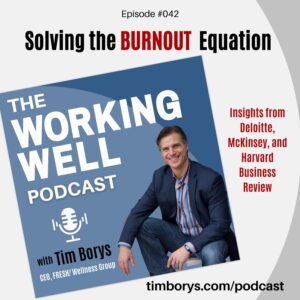
Podcast Summary
Employees and businesses are struggling to adapt to the new reality of work.
Almost every survey and research study highlights that people are more stressed, disengaged, and burned out than ever. This is despite the billions of dollars being spent each year on wellness, benefits, and employee engagement tools. Science and practical experience show us a clear solution, but most companies have failed to take the simple steps necessary for change to happen.
Welcome to episode 42 of the Working Well Podcast, the show that explores the rapidly changing landscape of work and wellbeing. Each episode, We dive into the hottest topics in leadership, employee wellbeing, and the future of work! I’m your host Tim Borys.
Episode Links & Resources
Connect with Tim here:
Tim’s Websites: www.timborys.com, www.freshgroup.ca
LinkedIn: https://www.linkedin.com/in/timborys/
Podcast Transcript
For a full transcript, please read this article: https://timborys.com/how-to-solve-workplace-burnout-insights-from-deloitte-mckinsey-and-harvard/
What is Burnout?
According to the World Health Organization (WHO), burnout is characterized by three dimensions:
- Feelings of energy depletion or exhaustion;
- Increased mental distance from one’s job, or feelings of negativism or cynicism related to one’s job; and
- Reduced professional efficacy.
The Biggest Issue with Addressing Burnout at Work
While many barriers exist, the biggest challenge I see to addressing burnout in business is that most senior leaders think they are doing a great job at addressing burnout and employee wellbeing!
In a recent study, almost 2/3 of workers say their health and wellbeing decreased from last year, while 3 of 4 executives believed the health of their workforce improved!
What are the causes of burnout?
While there’s no single cause of burnout, and many factors contribute to the overall impact, the most common factors in the burnout equation are:
Excessive workload
Unrealistic deadlines
Long working hours
Lack of support
Lack of role clarity and expectations
Low level of control/autonomy over your work
Dysfunctional Workplace Dynamics (ie. Toxic Workplace)
Neglecting self care habits
What is the solution?
Leadership is at the heart of reducing and ultimately preventing burnout. The first step is shifting mindset on three separate levels. A leader’s personal mindset around wellbeing, mindset of how employee wellbeing contributes to company performance, and the mindset around the strategies and tactics needed to improve employee wellbeing and change corporate culture.
Step 1: Personal Wellbeing Mindset
Step 2: Corporate Performance Mindset
Step 3: Status Quo Strategies and Tactics Mindset
Burnout References
https://www2.deloitte.com/us/en/insights/topics/talent/workplace-well-being-research.html
Deloitte. (2023) The Wellbeing Crisis is a Crisis of Leadership. Retrieved from [https://action.deloitte.com/insight/3187/the-wellbeing-crisis-is-a-crisis-of-leadership]
https://action.deloitte.com/insight/1568/burnout-is-a-current-problem-requiring-long-term-solutions
https://www2.deloitte.com/us/en/blog/human-capital-blog/2023/how-to-avoid-employee-burnout.html
McKinsey Health Institute. (2022, October 7) Beyond burnout: What helps—and what doesn’t [https://www.mckinsey.com/mhi/our-insights/beyond-burnout-what-helps-and-what-doesnt]
Edmonton Social Planning Council. (2023, February 8). CM: Job Burnout – Why We Need Equitable Access to Mental Health Services. Retrieved from [https://edmontonsocialplanning.ca/2023/02/08/cm-job-burnout-why-we-need-equitable-access-to-mental-health-services/#:~:text=Another%20found%20that%2047%25%20of,levels%20(Moore%2C%202022).]
Mayo Clinic Staff. (n.d.). Job burnout: How to spot it and take action. Mayo Clinic. Retrieved from [https://www.mayoclinic.org/healthy-lifestyle/adult-health/in-depth/burnout/art-20046642]
Harvard Business Review (2023, May 18). More Than 50% of Managers Feel Burned Out. Dawn Klinghoffer, Katie Kirkpatrick-Husk [https://hbr.org/2023/05/more-than-50-of-managers-feel-burned-out]
Hybrid Work Is Just Work. Are We Doing It Wrong? [https://www.microsoft.com/en-us/worklab/work-trend-index/hybrid-work-is-just-work]

